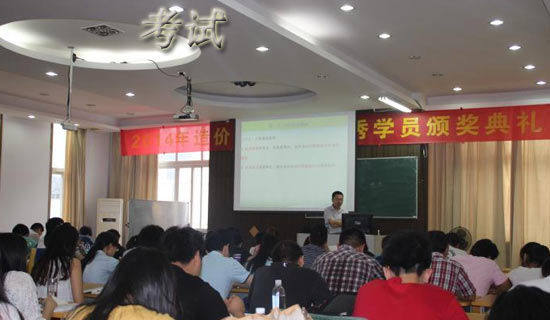- 相关推荐
历年英语CET4考试真题辅导
Soon learn, soon forgotten.以下是小编为大家搜索整理的历年英语CET4考试真题辅导,希望能给大家带来帮助!更多精彩内容请及时关注我们应届毕业生考试网!

Teaching children to read well from the start is the most important task of elementary schools. But relying on educators to approach this task correctly can be a great mistake. Many schools continue to employ instructional methods that have been proven ineffective. The staying power of the “look-say” or “whole-word” method of teaching beginning reading is perhaps the most flagrant example of this failure to instruct effectively.
The whole-word approach to reading stresses the meaning of words over the meaning of letters, thinking over decoding, developing a sight vocabulary of familiar words over developing the ability to unlock the pronunciation of unfamiliar words. It fits in with the self-directed, “learning how to learn” activities recommended by advocates (倡导者)of “open” classrooms and with the concept that children have to be developmentally ready to begin reading. Before 1963, no major publisher put out anything but these “Run-Spot-Run” readers.
However, in 1955, Rudolf Flesch touched off what has been called “the great debate” in beginning reading. In his best-seller Why Johnny Can’t Read, Flesch indicted(控诉)the nation’s public schools for miseducating students by using the look-say method. He said – and more scholarly studies by Jeane Chall and Rovert Dykstra later confirmed – that another approach to beginning reading, founded on phonics(语音学), is far superior.
Systematic phonics first teachers children to associate letters and letter combinations with sounds; it then teaches them how to blend these sounds together to make words. Rather than building up a relatively limited vocabulary of memorized words, it imparts a code by which the pronunciations of the vast majority of the most common words in the English language can be learned. Phonics does not devalue the importance of thinking about the meaning of words and sentences; it simply recognizes that decoding is the logical and necessary first step.
36. The author feels that counting on educators to teach reading correctly is _____________.
A) only logical and natural B) the expected position
C) probably a mistake D) merely effective instruction
37. The author indicts the look-say reading approach because _________________.
A) it overlooks decoding B) Rudolf Flesch agrees with him
C) he says it is boring D) many schools continue to use this method
38. One major difference between the look-say method of learning reading and the phonics method is _______________.
A) look-say is simpler B) Phonics takes longer to learn
C) look-say is easier to teach D) phonics gives readers access to far more words
39. The phrase “touch-off” (Para 3, Line 1) most probably means _____________.
A) talk about shortly B) start or cause
C) compare with D) oppose
40. According to the author, which of the following statements is true?
A) Phonics approach regards whole-word method as unimportant.
B) The whole-word approach emphasizes decoding.
C) In phonics approach, it is necessary and logical to employ decoding.
D) Phonics is superior because it stresses the meaning of words thus the vast majority of most common words can be learned.
【答案解析】
36. C)本题的线索是第一段的第二句话,其中的relying on educators与题干中的counting on educators 完全是同样的意思。
37. A) 作者先在第一段的最后一句说“look-say”或“whole-word”的阅读教学方法是失败的,第二段分析了这种方法失败的原因,是因为它“stresses the meaning of words over the meaning of letters, thinking over decoding…”
38. D) 文章在最后一段谈到了phonics method的特点和好处,本题线索见该段的第二句话“Rather than building up a relatively limited vocabulary of memorized words, it imparts a code by which the pronunciations of the vast majority of the most common words in the English language can be learned”,可见这种方法能使学习者获得更大的词汇量。
39. B) 本题要求利用上下文猜测单词的意思。根据第二段的最后一句,在1963年以前,出版的东西都是教授使用whole-word的方法的,紧接着用了转折词however,说在1955年,Rudolf Flesch“touched off”一场争论,因此此处的touch off必然是“引起”的意思。
40. C) 本题要求有较好的综合能力才能做得既快又准。从第二段中综合出whole-word阅读方法的特点:强调单词的意思、没有decoding;由此即可知B)、D)是错的;在文章的最后一句话,作者指出Phonics does not devalue the importance of thinking about the meaning of words and sentences,所以A)也是不对的。
【历年英语CET4考试真题辅导】相关文章:
专八英语考试历年阅读真题辅导08-19
学位英语考试历年真题辅导练习附答案09-02
商务英语中级考试历年真题08-09
商务英语中级历年考试真题09-11
商务英语中级考试的历年真题08-07
英语专业四级考试语言知识历年真题辅导09-02
英语四级考试历年词汇辅导真题训练及答案10-06
历年职称英语考试理工A真题训练题10-15
历年报检员考试真题精选10-06